July 2007
Monthly Archive
Sat 21 Jul 2007
Posted by Steve under
Awards1 Comment
Mystery News and Deadly Pleasures are pleased to announce the 2007 Barry Award nominations. The Barry Awards are named for of one of the most ardent and beloved ambassadors of mystery fiction, Barry Gardner, and are voted on by the readers of Mystery News and Deadly Pleasures. The 11th Annual Barry Awards presentation will take place at Bouchercon in Anchorage, Alaska in late September. The date, time and location of the awards presentation will be announced later. This is the first year that the Barry Awards are co-sponsored by Mystery News.
Best Novel
White Shadow by Ace Atkins
Oh Danny Boy by Rhys Bowen
The Last Assassin by Barry Eisler
The Prisoner of Guantanamo by Dan Fesperman
City of Shadows by Ariana Franklin
The Night Gardener by George Pelecanos
Best First Mystery
The Faithful Spy by Alex Berenson
Sharp Objects by Gillian Flynn
The Berlin Conspiracy by Tom Gabbay
The King of Lies by John Hart
Still Life by Louise Penny
A Field of Darkness by Cornelia Read
Best British Mystery
Priest by Ken Bruen
Dying Light by Stuart MacBride
Sovereign by C.J. Sansom
The Case of the Missing Books by Ian Sansom
Mr. Clarinet by Nick Stone
Red Sky Lament by Edward Wright
Best Thriller Novel
Killer Instinct by Joseph Finder
The Foreign Correspondent by Alan Furst
Relentless by Simon Kernick
Cold Kill by Stephen Leather
The Messenger by Daniel Silva
Kill Me by Stephen White
Best Paperback Original
Bust by Ken Bruen and Jason Starr
The Last Quarry by Max Allan Collins
The Cleanup by Sean Doolittle
Live Wire by Jay MacLarty
Deadman’s Poker by Jim Swain
Crooked by Brian Wiprud
Best Short Story
“Cain was Innocent” by Simon Brett (Thou Shalt Not Kill, published by Carroll & Graf)
“Shaping the Ends” by Judith Cutler (EQMM May, 2006)
“The Right Call” by Brendan DuBois (EQMM Sept/Oct, 2006)
“A Man of Taste” by Kate Ellis (EQMM Mar/Apr, 2006)
“The Flower Girl” by Paul Halter (The Night of the Wolf, published by Wildside Press)
“A Case for Inspector Ghote” by June Thomson (The Verdict of Us All, published by Crippen & Landru)
For more information about the Barry Awards, visit the Mystery News website at www.blackravenpress.com and the Deadly Pleasures website at
www.deadlypleasures.com. Questions about the awards and nominations can be directed to BarryAwards2007 [at] gmail.com or caldrich [at] blackravenpress.com.
Congratulations to all of the nominees!
Sat 21 Jul 2007
Posted by Steve under
Authors ,
Reviews1 Comment
JOHN CREASEY – The Toff Among the Millions. Walker & Co., US, hardcover, 1976. First Edition: John Long Ltd., UK, 1943; paperback reprints, UK: Panther, 1964; Corgi, revised edition, 1972.
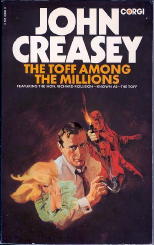
The title could be taken in two ways, I guess. What begins with Richard Rollinson’s determined attempt to throw ice cold water on a friend’s summer romance leads not unexpectedly to a case of murder, perhaps of a missing industrialist supposedly worth a good many pounds. Rumors being what they are, this could also have been called The Toff and the Stock Market.
Of course, as either protagonist or antagonist, the Toff is “one in a million,” so there you are. If you’ve never been properly introduced, the best description I could give might be that he’s a foppish sort of imitation of the Saint, complete with a devoted valet named Jolly, This particular book shows its age rather badly, however, and it’s not at all recommended for beginners. Just as in all too many bad radio dramas, the mystery is applied in layer upon layer of confusion and clod-pated characterization, so that at any stage the problem for the reader really becomes figuring out exactly what it is that’s going on. (C minus)
— From The MYSTERY FANcier, Vol. 3, No. 2, Mar-Apr 1979.
[UPDATE] 07-21-07. Ouch. I’m afraid that at the time I didn’t care very much for this one, did I? My general impression of the books in the Toff series has been that they’re very uneven, and perhaps the same might be said about Mr. Creasey’s work in general. This could have been one of the Toff’s lower spots, or perhaps it was I who might have been having a better day.
Or? Here’s another possibility. Creasey first wrote the book in 1943, and at least by 1972, if not earlier, it had been revised for the Corgi edition. I’m not sure how much rewriting might have been involved, but maybe it just didn’t work –the book was written in one era for one audience, and then revamped for another, more sophisticated one. In any case, here’s a book I’d like to have another chance at. Maybe someday.
Whenever anyone stops by where I live and asks me if I’ve “read all of these books,” my answer is always, “some of them more than once.”
Sat 21 Jul 2007
Posted by Steve under
Authors ,
AwardsNo Comments
MIKE DOOGAN – Lost Angel. Nominated for Best Private Eye First Novel of the Year, 2007.
Putnam, hardcover, August 2006. Paperback: Berkley, August 2007.
Book Description:
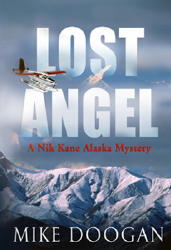
The icy interior of Alaska is the setting for this breathtaking first mystery from the winner of the Robert L. Fish Award for short fiction.
Lost Angel is an astonishing debut novel from Mike Doogan. In the tradition of Nevada Barr and C. J. Box, Doogan explores the darker side of man’s nature against the backdrop of stunning natural beauty.
Moses Wright founded the Christian commune of Rejoice. The rough-and-tumble interior of Alaska may seem a strange place for such a community, but for twenty years it has served as a beacon in the wilderness. Two decades later Moses granddaughter, Faith, is the star of the younger generation. Pretty and intelligent, she’s the first teenager in the town to choose to experience the outside world. When Faith disappears, the elders of Rejoice look beyond their village for help.
Ex-cop Nik Kane lost his faith long ago-dissolved in a bottle. A few drinks, a dark night, and a shooting led to seven years in jail for a crime he didn’t commit. Nothing can give him back his career or his family, but the search for Faith may restore his soul.
By turns lyrical and hard-edged, Lost Angel is a remarkable first novel from a powerful new voice in mystery fiction.
About the Author:
Mike Doogan has been called “the columnist Alaskans love to hate.” A third-generation native of the state, he lives in Anchorage. Currently, he is seeking a seat in the Alaska State House.
Review excerpts:
Publishers Weekly: “Meet Nik Kane, the charming star of a new series by Anchorage Daily News columnist Doogan. Kane, a 55-year-old ex-cop who’s also an ex-con, not to mention an ex-husband, heads to the Alaskan interior to do some detective work for a remote religious community called Rejoice. […] While Doogan telegraphs the solution to the riddle of Faith’s disappearance, engaging, lucid prose more than compensates.”
Booklist: “A white-knuckle flight in a bush plane over the Alaskan wilderness jump-starts this debut novel, establishing both the unforgiving setting and the desperate resolve of the main character. […] This is a richly textured novel on several counts. Kane is achingly well delineated; his struggle to adjust to a much bigger, louder, more confusing world after the confines of prison – and to try to find meaning in a life stripped bare of supports – is gripping. All the exigencies of struggling through an Alaskan winter ring true […], and the portrayal of a religious community that holds both secrets and dangers is fascinating. A top-notch start to a projected mystery series.”
Sat 21 Jul 2007
PAUL MALMONT – The Chinatown Death Cloud Peril.
Simon & Schuster; hardcover. First Edition: May 2006. Trade paperback: June 2007.
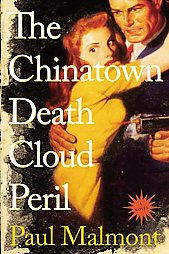
In 1937, the United States was in the midst of the Great Depression. For entertainment there was no television, only radio, the movies and – the pulps. The newsstands were filled with magazines made of cheap paper with lurid covers. Two of the best of these were The Shadow and Doc Savage, written by Walter Gibson and Lester Dent, respectively, although the general public knew them only by their pseudonyms, Maxwell Grant and Kenneth Robeson.
What Paul Malmont proposes in this almost hoot of a novel is that Gibson, Dent, and a gent named L. Ron Hubbard combined forces to solve the murder of a fellow writer, one H. P. Lovecraft, and to track down at the same time a fellow from China trying to give his country a step up on Japan in those desperate days before World War II.
Other real names which can be spotted in the narrative are Robert Heinlein, Chester Himes, Louis L’Amour and more than a few others. There is only one problem. No pulp novel ever took more than 150 pages to get started, as this book does.
The author seems to feel that many readers will need a long expository history of the pulp magazines before he can begin, along with the life stories of each of the primary protagonists. Those who do not require this information will be bored, I fear – unless they enjoy quibbling about the details – expecting a faster pace by far. As for the uninitiated for whom the background would be useful, I wonder how many of them will ever get past the background.
But when the book finally does take off, it’s hang-on-to-your-seatbelt time, there’s no doubt about it!
Note: This review appeared earlier in Historical Novels Review.
Sat 21 Jul 2007
Posted by Steve under
Authors ,
AwardsNo Comments
BRIAN M. WIPRUD – Crooked. Nominated for the PWA Best Private Eye Paperback Original of the Year, 2007, and for the Barry Award Best Paperback Original of the Year, 2007.
Dell, paperback, July 2006.
Book description:
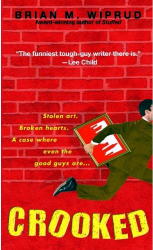
Nicholas Palihnic is a natty, tweed-suited hustler who knows every nook and cranny of New York – and a thousand ways to break a girl’s heart. Beatrice Belarus is a Manhattan art dealer with an insatiable appetite for money–and for anyone who gets in her way. And a painting titled Trampoline Nude, 1972 has neither nudity nor a trampoline. But when Nicholas is hired by an insurance company to find the recently stolen painting, a murdered art thief points him to a trove of gold buried beneath Manhattan – and suddenly all roads are leading back to Beatrice. As fortune hunters, lovers, and other strangers gather around him, there’s one thing Nicholas must remember above all else: in this business, it’s better to be crooked than dead….
About the Author:
Brian Wiprud attended NYU film school before settling on a career in utility infrastructure. He is an avid fly fisherman and collector of taxidermy, two hobbies which, improbably, feature in his novels. His latest accomplishments include:
* Independent Mystery Bookseller’s Association Bestseller
* 2002 Lefty Award for Most Humorous Novel
* 2003 Barry Award Nominee for Best Paperback Original
Review excerpt:
Publishers Weekly: “Wiprud’s engaging, hard-boiled style draws readers into both the art world and the underworld of New York, and his colorful cast keeps things moving with wit to spare – especially the plucky lead. Some pieces of this tale hang loose […] but the journey is a thrilling one, with an ending even the most astute readers won’t see coming.”
Nicholas Palihnic is the brother of taxidermy collector and dealer Garth Carson, who previously appeared in:
Pipsqueak. Dell, paperback, June 2004.
Stuffed. Dell, paperback, May 2005.
Newly released:
Tailed. Dell, paperback, May 2007. [with both Garth Carson and Nicholas Palihnic]
Fri 20 Jul 2007
ADAM BLISS – The Camden Ruby Murder
Grosset & Dunlap; hardcover reprint, no date stated. First edition: Barse & Co., hardcover, 1931.
According to the increasingly indispensable Crime Fiction IV, Adam Bliss was the pseudonym of Robert F. Burkhardt & Eve Burkhardt, husband and wife, as we shall see in a moment. They wrote three books under this pen name, to whit:
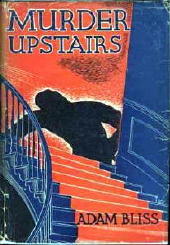
The Camden Ruby Murder, Barse, 1931. Grosset hc reprint.
Murder Upstairs, Macrae-Smith, 1934. Grosset hc reprint.
Four Times a Widower, Macrae-Smith, 1936.
The leading character in each of the last two is someone named Alice Penny, about whom I know nothing at the moment, but since I own one of the two books, present whereabouts unknown, I will tell you more about her, eventually, as soon as I locate the box I know that it is in. And read it. The book, that is, not the box.
The Burkhardts also wrote books as Rob Eden; there are five entries for them in CFIV under this name. And ordinarily, this is about all you might expect to learn about an obscure pair or writers like these, but no, the Internet does say more. With a judicious use of Google, I discovered a website devoted to events in 1947. What particular connection the Burkhardts have with 1947, I have not yet discerned, but I quote:
“And at the age of 55, after dozens of novels and countless short stories, he [Robert Burkhardt] died. Not that you’ve heard of him or any of his books – unless you collect potboiler novels of the 1930s.
“The list of his works is impressive in bulk if nothing else, with titles that tell the entire plot in two or three words: Dancing Feet, In Love With a T-Man, Love or Money, Modern Marriage and my favorite: Short Skirts: A Story of Modern Youth.
“Robert F. Burkhardt was born in Altoona, Iowa, and after a long apprenticeship as a reporter at a series of newspapers, he began handling publicity in the Hollywood studios: Fox, Paramount and Warner Bros. He and his wife, Eve, combined their names to form the pen name Rob Eden, adopting another pseudonym, Adam Bliss, for a series of mysteries.
“Today, not a single one of his volumes is in the collection of the Los Angeles Public Library. A Google search turns up very little on him or his widow.”
The works of Rob Eden, as taken from the website above, are the following. No claim is made (by me) as to completeness. [Those marked with a * are entries in CFIV; one marked with a ** perhaps should be.]
Always in Her Heart
Blond Trouble
Dancing Feet
Fickle
The Girl With Red Hair
Golden Goddess
Heartbreak Girl
Her Dream Prince
Her Fondest Hope
In Love With a T-Man ** [ Listed for sale elsewhere with this description: “Secretary falls in love with her Treasury Agent boss. Intrigue, romance.” ]
* Jennifer Hale
Kathie the First
* Loot
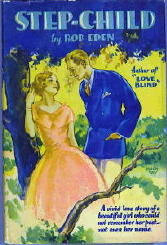
Love Blind
Love Came Late
* Love Comes Flying
Love or Money
Love Wings
The Lovely Liar
Lucky Lady
Men at Her Feet
Modern Marriage
Moon Over the Water
The Mountain Lodge
* A New Friend
Pay Check
Second Choice
* Short Skirts: A Story of Modern Youth
Step-Child
This Man Is Yours
Trapped By Love
$20 a Week
One other website indicates that the authors also wrote as Rex Jardin. If so, this may be a case of a missing entry in CFIV, as the one title found under this byline certainly sounds as though it may be crime-related: The Devil’s Mansion, Fiction League, 1931; Jacobsen, 1931?; Paperback Library, pb, 1966, as a gothic romance with the following blurb on the cover: “Janet was forced to escape the eerie old house or become the bride of the Devil himself!”
As for The Camden Ruby Murder itself, the good news is, to some of us – should I make that “most of us?” – is that this is a locked-room mystery. I’ll get to the (relatively) bad news in a minute. To set the scene first of all, the narrator, Gary Maughan; his host, Van Every, owner of the newly acquired (and priceless) Camden Ruby;and Maughan’s long-time acquaintance (and once his lover) stage star Margalo Younger, are in Van Every’s home, listening to him expound on the curse that has been placed upon the gem. When the story is completed, with its gory details, Margalo, who has apparently fainted, is discovered by the two men instead to be dead. Murdered by means of a poisoned needle found at the base of her brain.
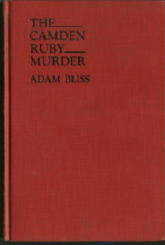
Mitigating circumstances: The door to the room was open, and a number of household members (and close friends) are eventually learned to have passed by, which seems to make matters less complicated, until (as time goes on) it is also learned that none of them could have committed the crime, more or less. Which is too bad, because none of them really did do it. In the hands of an author like John Dickson Carr, the flummery would have kept pace with the investigation, if not kept tantalizingly out in front instead of lagging behind, as it does here, which to my mind, at least, was a large disappointment, as the flummery itself is top-notch and worthy of, as I suggested above, better hands.
This book was written back in the day where the mystery, the murder, the crime, the investigation and the questioning were the beginning, the middle, and the end of the story. Not much time is spent on personal matters, unless and until they had a bearing on the case at hand. Maughan quickly gains the confidence of the investigating officer, one Captain Keyes, which (fortunately for the reader) gives Maughan, as the narrator, total and complete access to the entire investigation. He is therefore able to view it from every side and angle and than back inside out again.
Not that this amounts to more than a hill of peapods later on, at a key juncture of the story when Maughan, tired from slogging across town one time too many in the rain, turns down an opportunity for someone to tell him something important, something so important it would have solved the case then and there – halfway through the book – only for that person offering him the aforesaid opportunity, but denied, to become the second of the killer’s victims. (I am not telling you anything you should not know, for as Maughan himself says, immediately after turning said person away, “I would have given anything if only I … had listened…”)
Any weaknesses or problematic passages aside, I enjoyed reading this book, and if you are still with me in reading my comments thus far, I am somewhat of the opinion that you would too.
[UPDATE] 07-21-07. Al Hubin has agreed with me about the book by Rob Eden which I suggested be included in CFIV. You will find it under that author’s name in the ongoing online Addenda to the Revised Crime Fiction IV.
As for the book by Rex Jardin mentioned above, Al has informed me that it was included in Crime Fiction II. He removed it from later editions on the advice it was not criminous in nature. Any confirmation or factual information to the contrary would be welcome.
[UPDATE] 07-24-07. Jamie Sturgeon has found two more titles by Rob Eden, and Al Hubin has agreed that both of them warrant inclusion in CFIV. Details can be found in this later blog entry.
Fri 20 Jul 2007
Posted by Steve under
Authors ,
Awards[4] Comments
PACO IGNACIO TAIBO II & SUBCOMMANDANTE MARCOS – The Uncomfortable Dead; Carlos Lopez, translator. Nominated for Best Private Eye Paperback Original of the Year, 2007.
Akashic Books, trade paperback, September 2006.
Book Description:
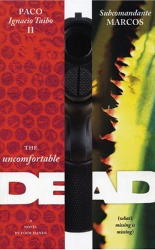
In alternating chapters, Zapatista leader Subcomandante Marcos and the consistently excellent Paco Ignacio Taibo II create an uproarious murder mystery with two intersecting story lines.
The chapters written by the famously masked Marcos originate in the mountains of Chiapas, Mexico. There, the fictional “Subcomandante Marcos” assigns Elias Contreras – an odd but charming mountain man – to travel to Mexico City in search of an elusive and hideous murderer named Morales.
The second story line, penned by Taibo, stars his famous series detective Hector Belascoarán Shayne. Hector guzzles Coca-Cola and smokes cigarettes furiously amidst his philosophical and always charming approach to investigating crimes-in this case, the search for his own “Morales.”
The two stories collide absurdly and dramatically in the urban sprawl of Mexico City. The ugly history of the city’s political violence rears its head, and both detectives find themselves in an unpredictable dance of death with forces at once criminal, historical, and political.
About the Authors:
Paco Ignacio Taibo II is a Mexican historian and writer, the author of numerous crime novels and historical works (two of which won the Planeta Prize for Literature), and the founder of Semana Negra, the annual international crime writers’ congress in Spain. He lives in Mexico with his wife and daughter.
Subcomandante Marcos is a spokesperson and strategist for the Zapatistas, an indigenous insurgency movement based in Mexico. He first joined the indigenous guerrilla group which was to become the Zapatistas in the early 1980s. Marcos is author of several books, including Story of the Colors, which won a Firecracker Alternative Book Award, and Our Word is Our Weapon.
Review excerpts:
Publishers Weekly: “Mexican crime writer Taibo and a real-life spokesperson for the Zapatista movement, Subcomandante Marcos, provide alternating chapters for this postmodern comedic mystery about good, evil and modern revolutionary politics. […] Taibo’s expertise ensures a smart, funny book, and Marcos brings a wry sense of humor. The authors mix mystery with metafiction: characters operate from beyond the grave or chat about the roles they play in the novel, and Marcos writes his fictional self into the story. Literary readers will nod and smile knowingly, though serious mystery devotees who prefer more grounded noir might be mildly annoyed by the hijinks.”
Booklist: “As one might expect, the political trumps the personal in this curious mix of crime novel and position paper, but it is just strange enough to attract a cult audience.”
Previous Hector Belascoarán Shayne novels: [English translations only.]
An Easy Thing. Viking, hardcover, 1990. Penguin, paperback, 1990. Poisoned Pen Press, trade paperback, 2002.
Some Clouds. Viking, hardcover, 1992. Penguin, paperback, 1993. Poisoned Pen Press, trade paperback, 2002.
No Happy Ending. Mysterious Press, hardcover, 1993. Warner, paperback, 1994. Poisoned Pen Press, trade paperback, 2003.
Return to the Same City. Mysterious Press, hardcover, 1996. Warner, paperback, 1997. Poisoned Pen Press, trade paperback, 2005.
Frontera Dreams. Cinco Puntos Press; trade paperback, July 2002.
Fri 20 Jul 2007
Posted by Steve under
Authors ,
AwardsNo Comments
P. J. PARRISH – An Unquiet Grave. Nominated for Best Private Eye Paperback Original of the Year, 2007.
Pinnacle, paperback, February 2006.
Book description:
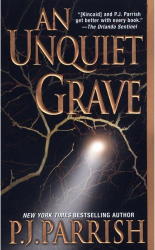
In a remote corner of the Michigan woods, behind rusted iron gates and crumbling walls, lies a notorious sanitarium and its forgotten cemetery. The ruin is empty now, and the bulldozers have come to raze it. But as they do, a secret emerges. The coffin of Claudia DeFoe, the youthful love of Louis’s foster father Phillip, is empty.
When Louis tries to find the remains, he crosses paths with a reporter searching out rumors that a former patient, assumed dead, is alive and killing again. In Hidden Lake hospital, where the walls are stained with secrets and the air thick with the history of lingering screams, Louis is on his darkest journey yet – into the mind of a deranged killer and into the locked rooms of his own psyche.
About the Authors:
P. J. Parrish (sisters Kelly Nichols and Kris Montee) is author of the critically acclaimed and New York Times bestselling Louis Kincaid series. Their books have been Edgar, Shamus, Thriller and Anthony award finalists. Both sisters, born in Detroit, Mich., were writers as kids, albeit with different styles: Kelly’s first attempt at fiction was at age 11 titled “The Kill.” Kristy’s at 13 was “The Cat Who Understood.”
Not much has changed: Kelly now tends to handle the gory stuff and Kristy the character development. But the collaboration is a smooth one, thanks to lots of ego suppression, good wine, and America Online.
Review excerpts:
Publishers Weekly: “Bestseller Parrish’s gripping and atmospheric new Louis Kincaid novel (after A Killing Rain) is a quality read that will remind many of Dennis Lehane. […] Parrish manages to make what could be a formulaic plot fresh, both through her gift at creating sympathetic main and secondary characters and through her skill at creating suspense and sustaining a mood. The author’s ability to raise goose bumps puts her in the front rank of thriller writers.”
Chicago Sun-Times: “An Unquiet Grave is a standout thriller. It is an intriguing and atmospheric story set largely on the grounds of an abandoned insane asylum, a haunting location that contains many dark and barbarous secrets. With fresh characters and plot, An Unquiet Grave is a suspense novel of the highest order.”
Previous Louis Kincaid books:
Dark of the Moon. Pinnacle, paperback, January 2000.
Dead of Winter. Pinnacle, paperback, January 2001.
Paint It Black. Pinnacle, paperback, January 2002.
Thicker Than Water. Pinnacle, paperback, January 2003.
Island of Bones. Pinnacle, paperback, January 2004.
A Killing Rain. Pinnacle, paperback, February 2005.
Newly released:
A Thousand Bones. Pocket, paperback, June 2007. [Kincaid takes a minor role in this case for his lover Joe Frye, the lone female homicide detective in the Miami-Dade Police Department.]
Fri 20 Jul 2007
Posted by Steve under
Authors ,
Awards1 Comment
PETE HAUTMAN – The Prop. Nominated for Best Private Eye Paperback Original of the Year, 2007.
Simon & Schuster, trade paperback, March 2006.
Book description:
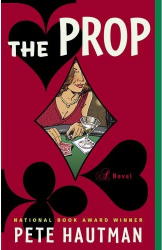
National Book Award winner Pete Hautman delivers a fast-paced mystery set in the torrid, unforgiving Southwestern desert, where the stakes are sky high and all bets are off.
Peeky Kane is a prop player at an Arizona casino owned by the Santa Cruz tribe. Her job is to play poker. She makes a handsome living off the suckers who populate the card room. Life is sweet.
But something’s not right at Casino Santa Cruz. When Peeky inadvertently finds herself in a fixed game and comes away a couple thousand dollars richer, she finds herself drawn unwittingly toward the dark side of professional poker. Peeky has always thought of herself as a straight shooter, but now things aren’t so clear. And they’re about to get a lot murkier.
When a band of clown-masked robbers makes off with millions of the casino’s dollars and leaves behind four corpses, Peeky recognizes one of the robbers as a casino employee, and fears that one of her closest loved ones might also be involved. That same day, Peeky’s son-in-law turns up to tell her that Jaymie, her beloved daughter, has been stealing money from Peeky for years to feed a crack habit.
Numb from these revelations, Peeky is compelled to action by an unlikely source when the most powerful member of the Santa Cruz tribe calls upon her to help him save his troubled casino. Peeky must draw on her years of reading poker faces and playing the odds to save the casino, her daughter, and herself.
Review excerpts:
Publishers Weekly: “Hautman’s Godless (2005) won a National Book Award for Young People’s Fiction, but his impressive, sharply written new crime thriller is definitely for adults — especially those who would rather play poker than do anything else. […] Peeky’s life takes a few sharp turns after some crooked dealers find a new way to steal money and make her an unwilling accomplice. As this short but action-packed novel shows, Hautman is the kind of cool, expert player who keeps the cards coming.”
Booklist: “A cop’s widow who was briefly on the force herself, Peeky is cruising into middle age when she notices a couple of dealers scamming jackpots. […] Signs point to an inside job, and Peeky finds herself both under suspicion and roped into investigating the crime — even as she must track down her troubled daughter with a potentially violent son-in-law. There’s a lot of muss and a little fuss, but Peeky maintains her wry, letting-it-all-hang-out vibe come hell or bad boyfriends. As an addition to the mystery game, she’s as welcome as pocket aces.”
An earlier series of books by Pete Hautman featured Joe Crow, Sam O’Gara, Axel Speeter, and Tommy Fabian, a group of small-town gamblers in Minnesota. (In some books they have only very minor roles):
Drawing Dead. Simon & Schuster, hardcover, Oct 1993. Pocket, paperback, October 1997.
Short Money. Simon & Schuster, hardcover, May 1995. Pocket, paperback, July 1997.
The Mortal Nuts. Simon & Schuster, hardcover, June 1996. Pocket, paperback, September, 1997.
Ring Game. Simon & Schuster, hardcover, October 1997. Pocket, paperback, October 1998.
Mrs. Million. Simon & Schuster, hardcover, March 1999. Pocket, paperback, March 2000.
Most, if not all, of the author’s other recent fictional work has been intended for the Young Adult market. For more information, this link will lead to his web page. This book appears to have been Peeky Kane�s first and only appearance, so far.
Thu 19 Jul 2007
JOHN R. L. ANDERSON – Death in the Channel
Stein & Day, hardcover, 1976. Reprint paperback: Stein & Day 88112, 1985. Detective Book Club [3-in-1 edition], hardcover, Jan-Feb, 1977. First published in England as Redundancy Pay,by J. R. L. Anderson: Victor Gollancz, hardcover,1976.
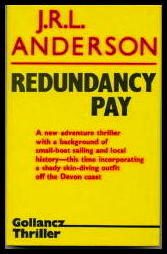
A young London accountant loses his job in a takeover by a larger firm, loses his wife to the joys and pleasures that only wealth can bring, and sick and tired of the continual chase for paper money, he heads back to his boyhood home to see whether or not livings can still be made from the sea.
In Finmouth he gets a job with lobster pots, is suspected for a while of stealing a priceless chalice left unguarded in a church vestry, but then discovers the connection between the crime and some divers searching for sunken treasure out in the English Channel.
It doesn’t take a mathematician to put together the correct equations and solve them, but it is exactly that sort of old-fashioned story that’s put together in just so precise a manner. The pacing bothered me a little, and there is a surprisingly large flaw in the logic at one point, but overall Anderson will strike you, I’m sure, as a writer who is reliably competent and solid. And decent. (C plus)
– From The MYSTERY FANcier, Vol. 3, No. 2, Mar-Apr 1979.
[UPDATE] 07-20-07. I’ve not been able to come up with a cover image for either US edition of this book. According to my records, I may no longer even own a copy. If I do, it’s nowhere it can be easily located. Thanks to British bookseller Jamie Sturgeon, though, what you see is the cover of Gollancz edition. Not as interesting as it might have been, but it’s still good to have.
In Crime Fiction IV, Allen Hubin indicates that Major Peter Blair, one of Anderson’s two major series characters is in this book, but Jamie has reassured me that he does not. Until I received an email from Jamie this afternoon, I was surprised to think that Blair was in the book and somehow I hadn’t managed to mention it in the review.
I don’t remember ever reading one of Major Blair’s exploits, but I could be wrong. For the sake of completeness, Anderson’s other detective character was Inspector Piet Deventer, one of whose cases I remember not caring for as much as I did Death in the Channel, but which one it was, I can no longer recall.
« Previous Page — Next Page »










